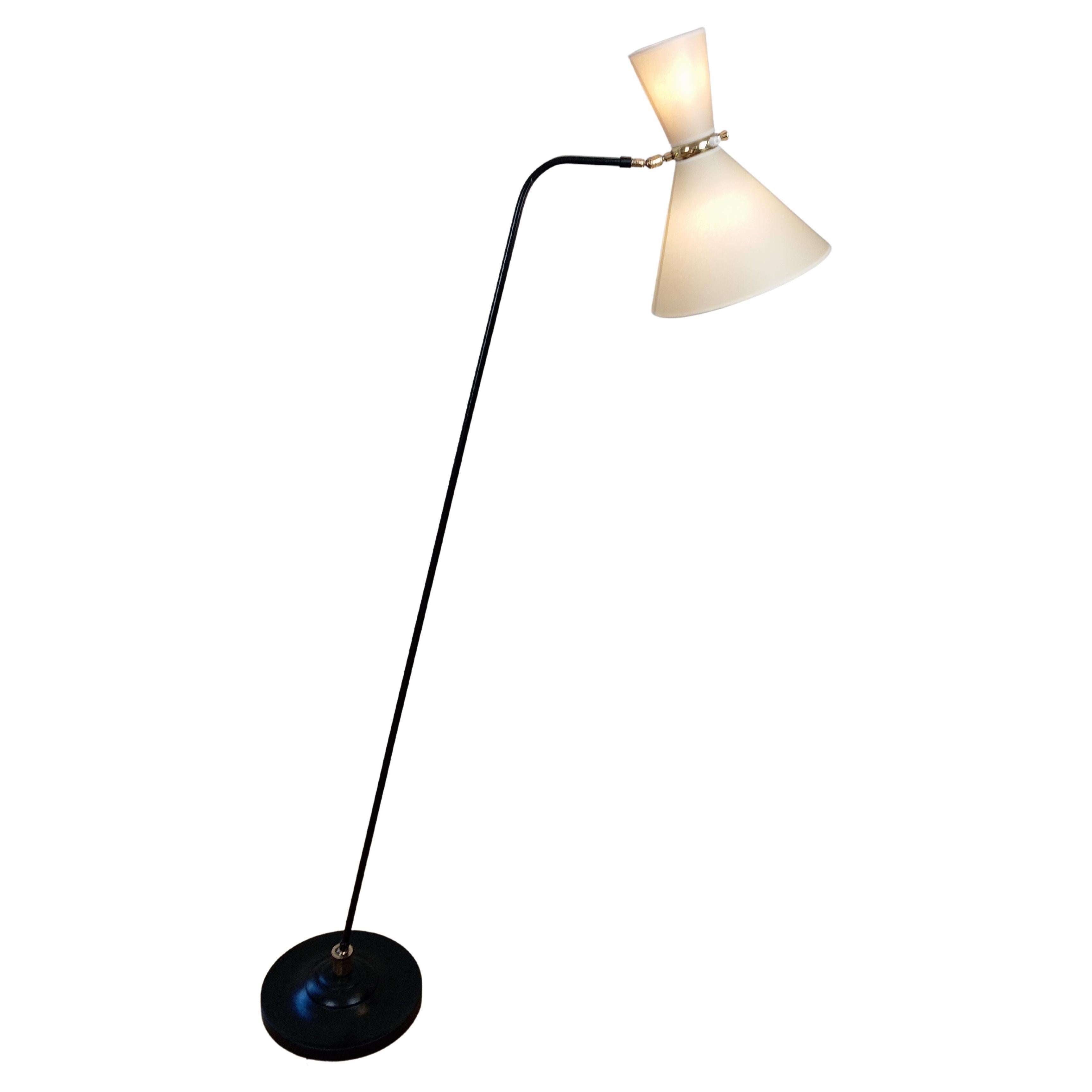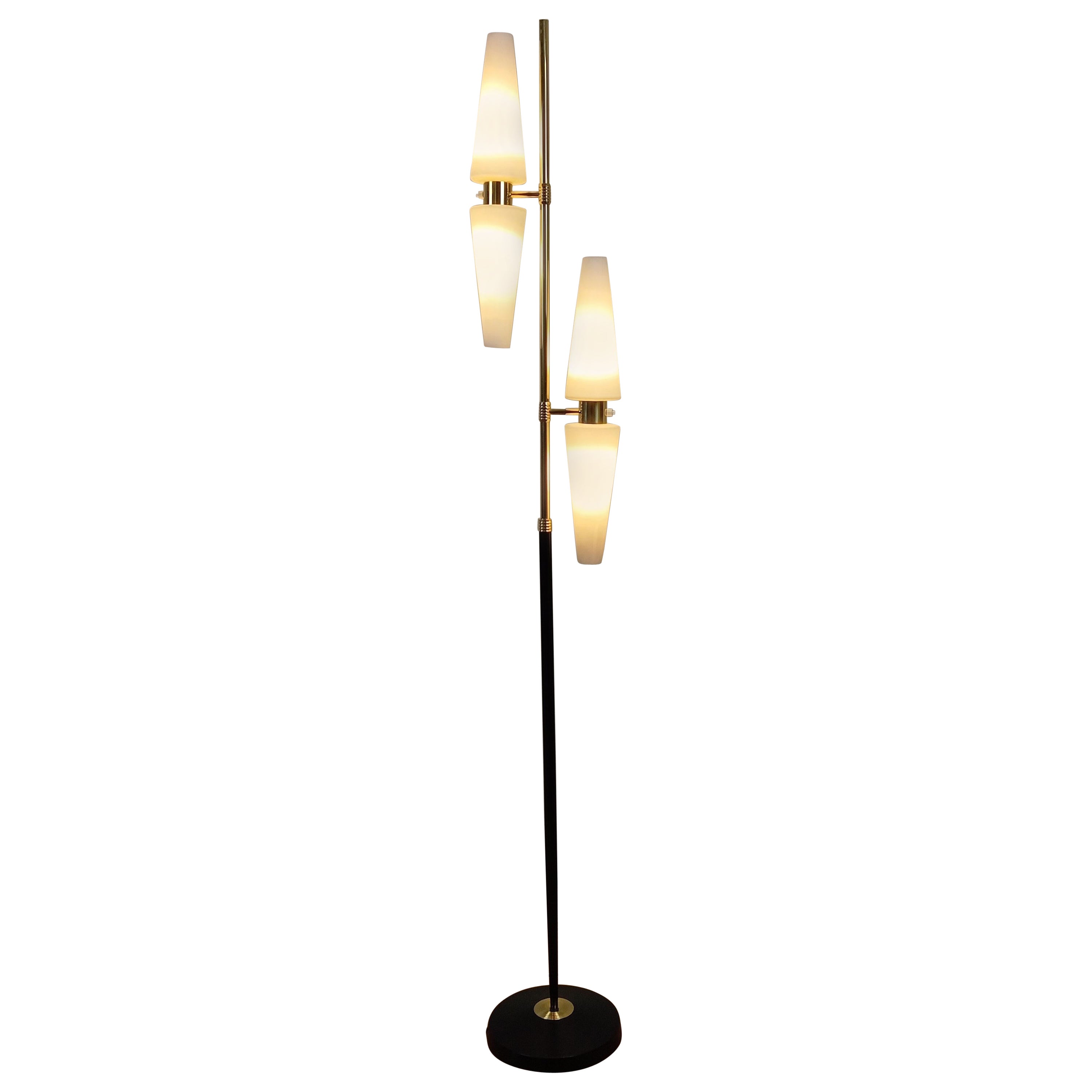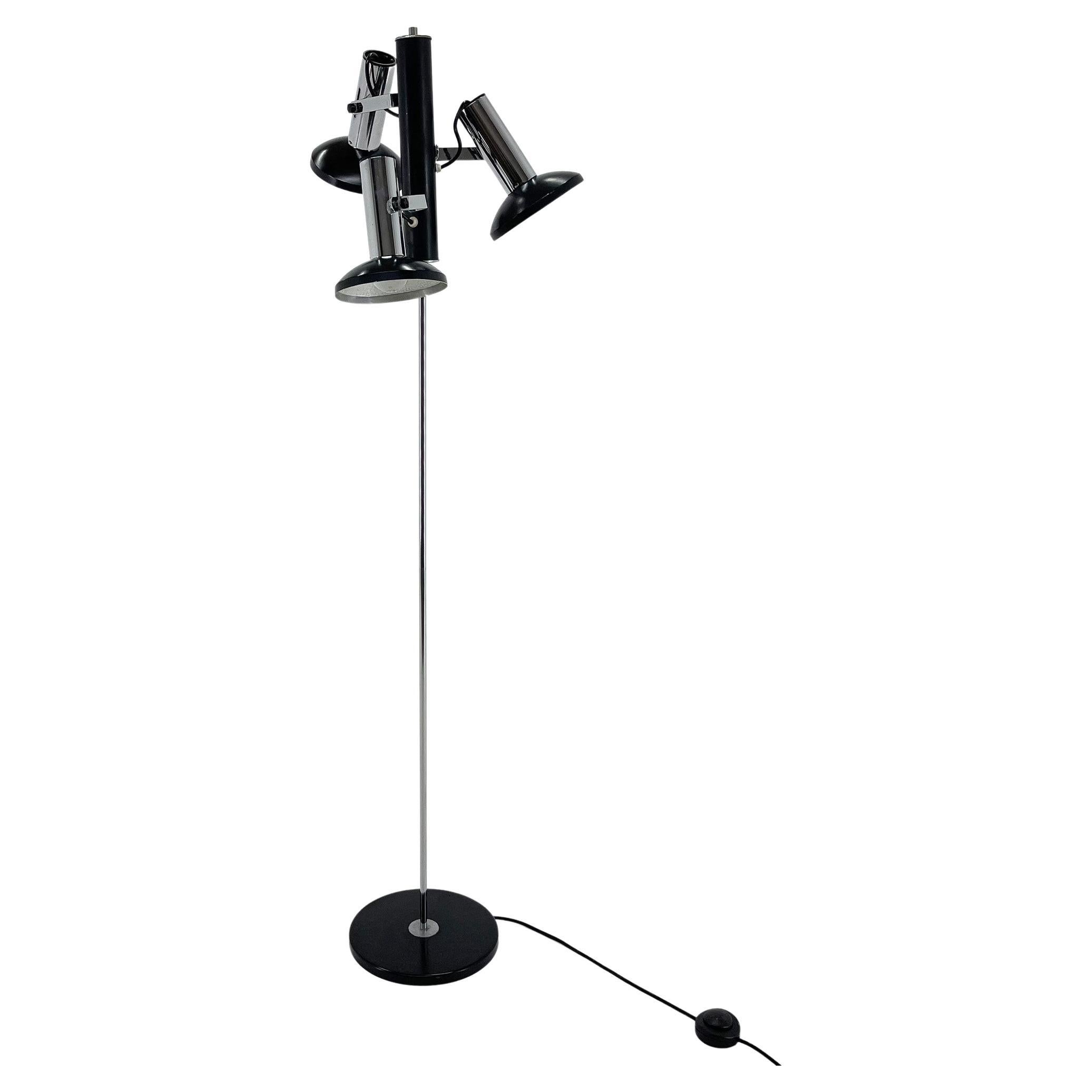Items Similar to Vintage Monix Floor Lamp 3 Orientable Spots, Édition 1960
Want more images or videos?
Request additional images or videos from the seller
1 of 13
Vintage Monix Floor Lamp 3 Orientable Spots, Édition 1960
About the Item
Rare Monix floor lamp 3 adjustable and orientable spots on a metal barrel nickeled and lacquered black, foot circular base. Each spot has its own switch to be adjusted and can be used as a reading lamp.
- Creator:Edition Monix (Manufacturer)
- Dimensions:Height: 74.41 in (189 cm)Diameter: 9.45 in (24 cm)
- Materials and Techniques:
- Place of Origin:
- Period:
- Date of Manufacture:1960
- Condition:
- Seller Location:Paris, FR
- Reference Number:
About the Seller
5.0
Vetted Seller
These experienced sellers undergo a comprehensive evaluation by our team of in-house experts.
Established in 2017
1stDibs seller since 2019
53 sales on 1stDibs
Typical response time: 1 to 2 days
- ShippingRetrieving quote...Ships From: Paris, France
- Return PolicyA return for this item may be initiated within 14 days of delivery.
More From This SellerView All
- Rare Large Vintage Industrial Projector Paris, circa 1960Located in Paris, FranceRare large vintage projector brand BBT on tripod and original casters Large projector manufactured by the company Barbier, Benard and Turenne (BBT) ...Category
Mid-20th Century French Industrial Floor Lamps
MaterialsSteel, Iron
- Sculptural Marble Lamp Space Age Shape, circa 1970sLocated in Paris, FranceSculptural lamp in Carrara marble with a conical shape, illuminated from the inside, it lets a light diffused that reveals the veins of the Carrara marble. Three plexiglass discs at ...Category
Late 20th Century Italian Floor Lamps
MaterialsCarrara Marble
- Fabulous Vintage Ruby Red French Crystal Table Lamp by Saint Louis ManufactureBy Cristalleries De SevresLocated in Paris, FranceExceptional and very rare handcut table lamp is in a clear and rich ruby red color double-layered crystal, it is a piece who required time for her shaping, outline, engrave and notch...Category
Late 20th Century French Table Lamps
MaterialsCrystal
- Black Skull Marble Table by John Bizas limited Edition 1/8Located in Paris, FranceThe black Skull table is a limited edition of 8, designed and produced in Italy by the artist John Bizas. Its design following some of the rococo style p...Category
21st Century and Contemporary Italian Rococo Sofa Tables
MaterialsMarble
- French Artist Charles Lapicque Tapestry Limited Edition 1/2 "Pelops", 1964By Charles LapicqueLocated in Paris, FranceExceptional limited edition 1/2 tapestry "Pelops" with certificate from a private collection, 1964. Ateliers Pinton brothers in Felletin, under the supervision of Pierre Baudouin 2ex + 1EA Editor Aram Iynedjian. The tapestry will be sold with its certificate of authenticity from the gallery. From the 15th century, the name of Pinton was associated with the Aubusson tapestry. Since then, over the generations, the Pinton family has largely contributed to the development of this fabulous cultural heritage until the creation in the 19th century, of the Felletin factory, in the department of Creuse. Even today, in these workshops, the craftsmen execute the same correct gestures with the same attention to detail and thus extend the chain of the history of the tapestry of tradition but also contemporary. The hand of specialists, the eye of designers and dyers and the taste of the most demanding clientele find their meaning in the fabric of the carpets. The excellence of French know-how, a living heritage society and custodian of Aubusson's cultural heritage, has always collaborated with great artists. The works of Charles Le Brun, Charles Lapicque, Pablo Picasso, Jean-Michel Othoniel, and many other big names in the world of painting, architecture, design, fell into the looms and know-how ancestral of this unique Creuse creator. Editor Aram Iynedjian Aram Iynedjian, Lausanne gallery owner and editor of tapestries from Braque, Estève and Lapicque, the latter meets Pierre Baudouin, the most famous of the cardboard painters of the time. The one who translated the works of Le Corbusier, Calder or Picasso into tapestry then collaborates with Charles Lapicque and they will develop a work of great richness. Lapicque came to realize these two summits which are "Pélops" and "Diane et Actéon". I realize that you should never try to describe a work of art Let’s look at it. Let us admire the science of composition, linear purity, technical perfection, the beauty of color, the truth of the drama. Let us see, if we can, the implacable presence of genius. "We will now understand that after having based a painting on the love of tapestry, it was relatively easy, and very tempting, to build a tapestry faithful to my painting," explained the artist in the exhibition catalog. of the Galerie Verrière in 1970. It was not until 1961 that he began to produce cardboards both for the tapestry of the Lisse in Aubusson, but also at the Mobilier National, with the help of Pierre Baudouin Charles Lapicque (1898-1988) Born in 1898 in Theizé (Rhône) in a family practicing both the arts and the sciences, Charles Lapicque is no exception to the rule: gifted for music and drawing, he graduated from the École Centrale in 1921, works as engineer until 1928 before integrating in 1931 a laboratory at the Faculty of Sciences of Paris, where he carried out research on the perception of colors, crowned by the title of Doctor of Physical Sciences in 1938. He thus studies the reactions of the eye in front of an intense light source, at the origin of the formation of starry images which he will use in his works, and defines a theory of the staggering of colors in space which overturns the rules of the Renaissance: "I had shown that the Classic rule, that of Vinci, advocating placing the blues in the distance, the reds, oranges and yellows in the foreground, is a nonsense; it makes more sense, more favorable to do the opposite. "(In Red and blue in the arts, 1936) It was around 1920 that Charles Lapicque began to paint in Brittany where he spent every summer since his childhood, first on the motif and then in a workshop that his stepfather Jean Perrin, Nobel Prize in Physics, had him build in 1927 ; he then definitively adopted the work of memory, in accordance with the art of music which he deeply loved and the Bergsonian philosophy of knowledge: "It is up to us to give reality an appearance that it has no itself, a form, a figure (...). " His youthful production immediately reveals a great originality, oscillating between figuration and abstraction which sometimes intertwine: alongside synthetic paintings by their simplified drawing and their flat colors, he designs an Homage to Palestrina (1925), composed of a grid derived from Cubism, entirely abstract, relayed by a Christ with Thorns (1939), according to a principle that he will develop after 1939, in line with his optical discoveries. In fact, during the war years, an almost abstract period began, that of the tight blue framework, applied to backgrounds ranging from yellow to red and revealing a more or less identifiable world (Jeanne d'Arc crossing the Loire, 1940; Rencontres series, 1940-1945). Exhibited in 1929 by the gallery owner Jeanne Bucher, Lapicque abandoned his scientific career in 1943 to devote himself entirely to painting. He continued his work which resulted in 1946-1953 in white-frame structures; their much softer lines lead him to the system of either black or white interlacing which encloses areas of pure color, most often in solid color. With The Battle of Waterloo in 1949, Lapicque still uses optics - zooming in on a given area - to depict spaces with multiple perspectives and decomposed times. This new interest in the liveliness of color developed in the following period, which can be described as flamboyant or Baroque (1954-1963): illustrated in particular by the series of Breton lagoons and twilight or nocturnal views of Venice in the light. Stars, which the artist himself describes as “daring sweets”, it begins with the Raoul Dufy Prize of the Venice Biennale, awarded in 1953 to the artist who took the opportunity to give free rein to his passion for the Serenissima until July 1956. Another point in common with his elder brother is the expression of movement. Begun in 1949 in The Battle of Waterloo then in 1952 with Dimanche aux regates, it became an obsession from 1964, in the exploration of new themes, such as the different shots of tennis players captured on the fly (1965), the mythological scenes and sea storms. These dizzying years precede the artist's last period: as he comes of age, he discovers serenity, revealed by a painting now with acrylic paint, much more peaceful from 1974, which even borders on a childish naivety at the end. of his life. All of his work includes an astonishing diversity of themes, also nourished by his travels (Rome in 1957, Greece in 1964, Holland in 1974 ...), with a predilection for the sea, rocks, sailboats, music, tennis, horses, wild beasts, but also for history and mythology, as evidenced by knights, kings and ancient gods. It also deploys, in total creative freedom, a wide variety of styles and orientations. Having been one of the pioneers of non-figurative art, thus paving the way for artists like Manessier, Bazaine, Vieira da Silva, De Staël, etc. Owners of the new non-figurative Paris School of the Postwar period, Charles Lapicque then returned to figuration, in a "new interpretation" of appearance, even if he continued to rub shoulders with abstraction at times. "Drawing runs after color and color after drawing. " Heir to the Fauves, Charles Lapicque plays like them on pure colors, whose dissonances, associated with a totally free design and an overloaded composition in a multiple space, make him a precursor of the New Figuration in all its forms: the Narrative Figuration born in France in the early 1960s, represented in particular by Gérard Fromanger, Erró, Bernard Rancillac and Gérard Guyomard; Free Figuration born in the early 1980s, marked by Robert Combas, Hervé and Richard Di Rosa, Louis Jammes and François Boisrond, and which, in turn, influenced the American Bad Painting of a Jean-Michel Basquiat or a Keith Haring, deliberately neglected and Expressionist; Lapicque's “Classic subjects” were able to feed Cultivated Painting, which also appeared in the early 1980s with Jean-Michel Alberola, Patrice Giorda and Gérard Garouste...Category
Mid-20th Century European Tapestries
MaterialsWool
- Marc Roussel French Ceramist, Saint Portrait, Vallauris, 1960sBy Marc RousselLocated in Paris, FranceA very rare and beautiful portrait of a Saint, a polychrome ceramic signed hand on the reverse Marc Roussel. Marc Roussel is the father in Law of François Lembo, as his son-in-law h...Category
Early 20th Century French Contemporary Art
MaterialsCeramic
You May Also Like
- Articulated floor lamp, Maison Monix circa 1950By Edition MonixLocated in Saint-Ouen, FRFloor lamp in black lacquered metal, cast iron and brass. Composed of a circular cast-iron base, on which a black-lacquered metal light arm articulated by a brass ball joint is arran...Category
20th Century French Mid-Century Modern Floor Lamps
MaterialsMetal, Brass
- Brass 4-light floor lamp Maison Monix circa 1950By Edition MonixLocated in Saint-Ouen, FRFloor lamp in black lacquered metal and brass. Composed of a circular base on which is fixed a conical metal and brass arm. 4 conical shades in white opaline glass are fixed to brass...Category
20th Century Mid-Century Modern Floor Lamps
MaterialsMetal, Brass
- Monix Black Nickel Reading Floor Lamp, France 1950'sBy Edition MonixLocated in New York, NYBlack nickeled adjustable floor lamp, the base can be angled in any direction, the stem telescopes and the head is on a swivel.Category
Mid-20th Century French Mid-Century Modern Floor Lamps
MaterialsBrass
- Monix Adjustable Brass Floor Lamp, France, 1960Located in New York, NYVersatile floor lamp by Monix, the base has a large swivel, the stem is adjustable as is the socket. Rewired. Shade for photo purposes a custom one can be ordered on request. Origina...Category
Mid-20th Century French Mid-Century Modern Floor Lamps
MaterialsBrass
- 1960's Chrome 3 Spot Floor Lamp, ItalyLocated in Praha, CZItalian vintage floor lamp in chrome and black metal. The lamp has three adjustable spot lights in all directions. Good vintage condition with so...Category
Mid-20th Century Italian Mid-Century Modern Floor Lamps
MaterialsMetal, Chrome
- Spot Floor LampBy Gino Sarfatti, ArteluceLocated in München, DEStunning floor lamp from the 1960s. Very unusual design and very high quality workmanship. Individually adjustable spots. An absolute highlight for every home. Condition: Ve...Category
Vintage 1960s Italian Mid-Century Modern Floor Lamps
MaterialsMetal
Recently Viewed
View AllMore Ways To Browse
Spot On
Vintage Spot
Antique Spots
Century Orient
Spot Lighting
1960 Metal Floor Lamp
3 Floor Lamp
Switch 3
Spot Lamp
Vintage Lacquer Lamp
Antique Vintage Lighting
Vintage Antique Lighting
Vintage Lighting Antique Furniture
Antique 1960
1960 Antique Furniture
1960 Furniture Antique Furniture
Antique Floor Lamp Base
Antique Lamps Vintage





